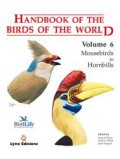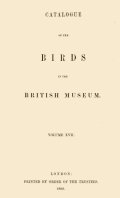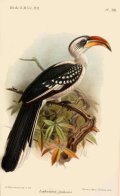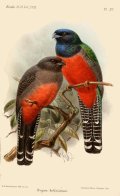On this page
Books about MousebirdsThis page lists books that are totally or partially about Mousebirds. The books are listed in order of publication date with the most recent at the top.
Mousebirds
Family: Coliidae
There are six extant species of mousebirds all of which are found in sub-Saharan Africa.
Red-backed Mousebird
Colius castanotus
Speckled Mousebird
Colius striatus
White-backed Mousebird
Colius colius
White-headed Mousebird
Colius leucocephalus
Blue-naped Mousebird
Urocolius macrourus
Red-faced Mousebird
Urocolius indicus
|
|
|
|
Handbook of the Birds of the World, Vol. 6: Mousebirds to HornbillsEdited by Josep Del Hoyo, Andrew Elliott and Jordi Sargatal
Lynx Edicions
2001
This volume covers mousebirds, trogons, kingfishers, todies, motmots, bee-eaters, rollers, ground-rollers, cuckoo-rollers, hoopoes, wood-hoopoes and hornbills.
|
Buy from amazon.co.uk 
|
|
Catalogue Of The Picariae In The Collection Of The British MuseumCoraciae continued and Halcyones (Leptosomatidae, Coraciidae, Meropidae, Alcedinidae, Momotidae, Todidae, and Coliidae)
Catalogue Of The Birds In The British Museum, Volume XVII
R. Bowdler Sharpe
17 colour plates: J.G. Keulemans (16), J. Smit (1)
Printed By Order Of The Trustees
Sold by: Longman & Co.; B. Quaritch; Kegan Paul, Trench, Trubner & Co.; and at the British Museum (Natural History)
1892
From the preface: "The present Volume contains an account of the remaining families of the suborder Coraciae as understood by Seebohm, as well as of the Halcyones, Bucerotes, and Trogones. The numbers of the species of the nine families treated of, and of the specimens at present in the Collection, are as follows: Leptosomatidae, 2; Coraciidae, 25; Meropidae, 36; Alcedinidae, 183; Momotidae, 21; Todidae, 5; Coliidae, 10; Bucerotidae, 68; Trogonidae, 47. Of these 397 species, only 16 are wanting to the collection of the Museum, and more than one-fourth of them are represented by the types; but besides these there are 30 other typical specimens now considered identical with previously named species. In many cases the series of specimens is sufficiently complete to illustrate the whole geographical range of a species - a result chiefly due to the accession of the great faunistic collections referred to in the previous volumes, and also to numerous recent donations, of which those made by the Lords of the Admiralty, Dr. Jayakar, W. D. Gumming, Esq., and Captain Mochler Ferryman should be specially mentioned. The Tweeddale Collection contained nearly the whole of the materials described in Dr. 8harpe's Monograph of the Alcedinidae."
|


 |
|